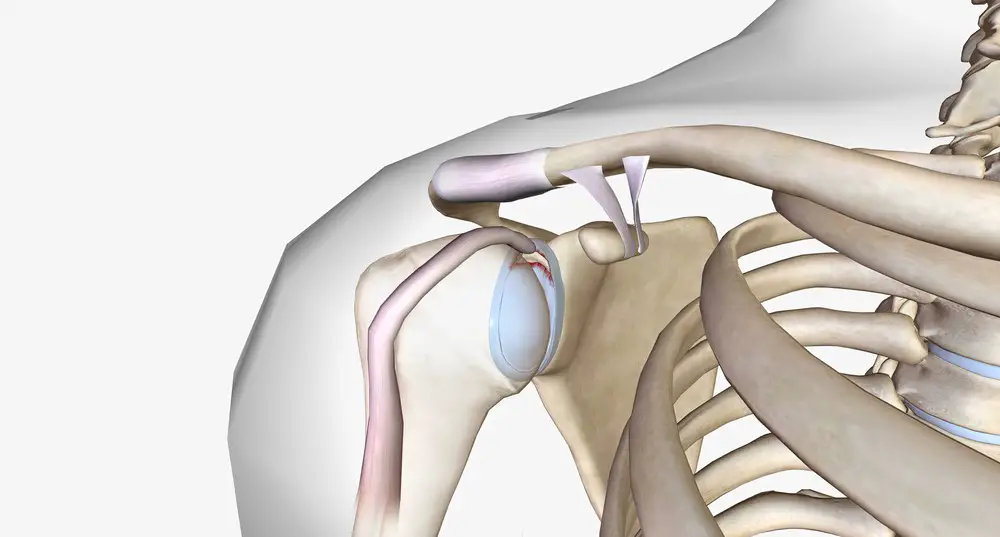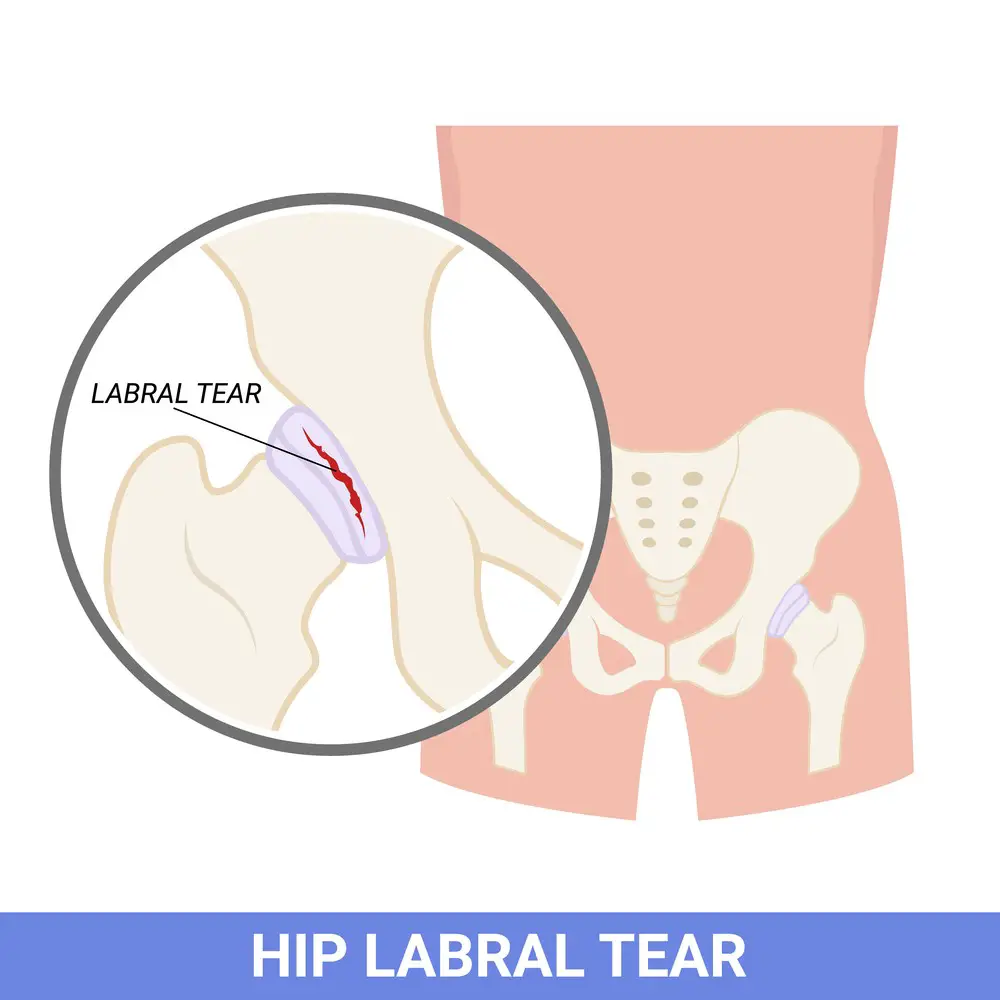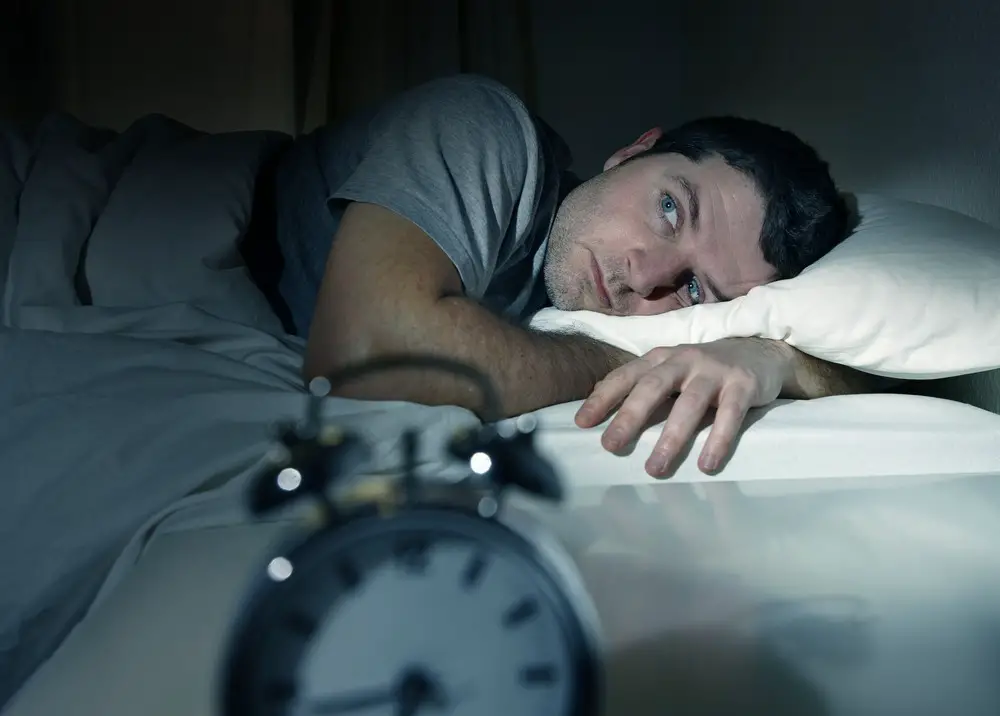As a BetterHelp affiliate, we receive compensation from BetterHelp if you purchase products or services through the links provided
A labral tear can cause discomfort and make it challenging to find a comfortable position for sleeping. The labrum is a piece of fibrocartilage that holds the ball and socket joints together in the shoulder and the hip. When this tissue gets damaged, it can result in pain, instability, and stiffness, disrupting your daily activities and sleep routine. This article will discuss ways to improve sleep quality with a labral tear.
Understanding the impact of a labral tear on your sleeping habits is crucial to finding an appropriate solution. Identifying your symptoms and seeking medical consultation will help determine the most suitable treatment options and practical exercises for recovery. One of the key factors for a good night’s sleep is finding the right sleep position. You can reduce the pain and discomfort associated with a labral tear by accommodating your injured shoulder or hip.
Key Takeaways
- Addressing labral tear symptoms and finding the proper sleep position is crucial for a good night’s sleep.
- Medical consultation and treatment options support the healing process and recovery.
- Prevention of further injuries and awareness of relevant conditions are essential for long-term well-being.
 Understanding Labral Tear
Understanding Labral Tear
Labral tears are injuries to the piece of cartilage called the labrum, found in ball-and-socket joints like your hip and shoulder. This cartilage helps keep the joint’s ball and socket parts stable and well-cushioned. In addition, the labrum is attached to tendons and ligaments, so when it’s injured, it can disrupt the normal functioning of the joint.
These tears can occur for various reasons, such as trauma from a sports injury or a fall. In some cases, repetitive motions in sports or other activities can lead to a labral tear through overuse and wear. Finally, some people might have a labral tear due to abnormalities in the shape or alignment of their hip or shoulder bones, causing increased stress on the labrum.
The symptoms of a labral tear can vary, but you commonly experience pain, reduced range of motion in the joint, and a feeling of the joint locking up. You should always consult a healthcare professional for proper diagnosis and treatment.
Finding a comfortable position with a labral tear can be challenging in terms of sleeping. When dealing with a hip labral tear, sleeping on your back with a pillow under your knees might help relieve pressure on the hip joint. Alternatively, you can try sleeping on your non-injured side with a pillow between your legs for added support. For a shoulder labral tear, you could try elevating the affected shoulder with pillows or using an arm sling to support your arm while you sleep.
Remember, it’s crucial to experiment with different positions and find what works best for your situation. Additionally, applying heat or cold to your affected joint before bed might help to reduce inflammation and alleviate pain. Make sure to listen to your body and give it the time it needs to heal while working with your healthcare professional to find the best course of treatment.
Understanding your labral tear and its causes is crucial in finding ways to sleep comfortably and promote recovery. Adjusting your sleeping position, using heat or cold therapy, and following the advice of your healthcare professional will go a long way in making your nights more restful and, ultimately, help you heal faster.
Symptoms to Look Out For
When dealing with a labral tear, it’s essential to be aware of the symptoms, as they can affect your sleep and overall well-being. Keep an eye out for the following signs:
- Pain: You might feel pain in the hip, groin, or buttocks, especially when walking or running. This pain can also disturb your sleep at night.
- Clicking or locking sensation: As you move, you may notice a clicking or locking feeling in the hip joint. This can be both uncomfortable and alarming.
- Reduced or limited range of motion: Experiencing stiffness or a limited range of movement in your hip is another common symptom of a labral tear.
Here’s a list of specific symptoms you should watch out for during the day and at night:
- Pain in the hip, groin, or buttocks
- Clicking, locking, or catching sensation in the hip
- Stiffness in the hip joint
- Difficulty walking
- Limited range of motion
Remember, some labral tears may not present any symptoms for years, so paying close attention to any changes you feel in your hip and discussing them with your healthcare professional is crucial.
As you learn to manage these symptoms, it’s key to find ways to sleep comfortably at night—experiment with different positions, like sleeping on your back or using pillows for support. Don’t hesitate to consult your doctor for personalized recommendations to ensure a good night’s sleep while dealing with a labral tear. Your rest and recovery is vital, so take care of yourself and stay attentive to your body’s signals.

How Aging Influences Labral Tear
As you age, your body undergoes natural changes that can impact your susceptibility to labral tears. The labrum, a cartilage found in the shoulder joint, connects the arm bone (humerus) to the shoulder blade. With time, wear and tear can cause this cartilage to weaken, making it more prone to injury gradually.
Arthritic changes are common as you age, which plays a significant role in developing labral tears. Hip and shoulder joints can become stiff and less flexible, putting extra pressure on the labrum. Here’s what you need to know about the connection between aging, arthritis, and labral tears:
- Wear and tear: Over the years, the consistent use of your joints has led to general wear and tear. This affects the labrum and can make it more likely to experience a tear.
- Reduced lubrication: Aging can decrease joint lubrication, which is essential for smooth movement. This reduction can increase friction within the joint, making it more susceptible to labral tears.
- Arthritis: Arthritis is an inflammatory condition that often develops with age. It can cause cartilage degeneration and increase the risk of labral tears. Arthritis can also exacerbate already-existing labral tears by increasing pain and inflammation.
- Decreased muscle strength: As you age, you may experience a gradual decline in muscle strength. Weaker muscles can place undue stress on the labrum, increasing the risk of a tear.
Acknowledging the influence of aging on labral tear development is vital, as being aware of these factors can help guide your decisions and actions in caring for your joints. Implementing a healthy lifestyle and staying active can go a long way in protecting your labrum from tears.
Diagnosis and Medical Consultation
When experiencing symptoms associated with a labral tear, it’s essential to consult a doctor for a proper diagnosis. Your doctor will start by examining your medical history and perform a physical exam to check for pain and evaluate your hip’s range of motion. They might also watch you walk to assess any imbalances or stiffness. As a patient, it’s essential to openly discuss your concerns and symptoms, especially groin pain commonly associated with labral tears.
To determine if a labral tear is present, your doctor may suggest imaging tests such as X-rays or magnetic resonance imaging (MRI) scans. X-rays can provide an initial assessment of the hip joint, while an MRI can offer a more detailed view of soft tissues and potentially detect labral tears.
Upon receiving a diagnosis, your doctor will discuss the potential treatment options. These may include:
- Physical therapy: improving hip joint stability and strength
- Pain management: using medications and injections for relief
- Surgical intervention: repairing or removing the damaged labrum
During your medical consultation, it’s essential to openly communicate with your doctor and ask any questions you may have. This will help you understand the condition better, set realistic expectations, and optimize recovery.
Key Takeaway: Diagnosis and medical consultation are crucial in identifying a labral tear and devising a suitable treatment plan, ensuring a course of action that caters to your needs. Don’t hesitate to discuss your concerns and symptoms; doing so will support your recovery.
Treatment Options for Labral Tear
A labral tear can certainly make sleep a challenge. Luckily, various treatment options can help alleviate the pain and improve overall quality of life. Here, we’ll briefly explore some of the most common treatment methods to address labral tears.
Physical Therapy: One of the main non-surgical treatments for labral tears is physical therapy. A trained professional will guide you through exercises and stretches tailored to your needs. This approach aims to strengthen the muscles surrounding your hip, improve joint mobility, and reduce discomfort. As you progress through your therapy, you may find that sleeping with a labral tear becomes less daunting.
Medications: To tackle inflammation and pain, you may be prescribed anti-inflammatory drugs such as ibuprofen or naproxen sodium. These medications can provide temporary relief and make resting more comfortable.
Injections: Corticosteroid injections directly into the joint can help control pain and inflammation. While not a long-term solution, these injections may offer significant relief, allowing for better sleep and continued physical therapy.
Arthroscopic Surgery: If conservative treatments have not provided adequate relief or your labral tear is severe, surgical intervention may be required. Arthroscopic surgery is a minimally invasive procedure that repairs or trims the damaged labrum tissue. You should gradually experience improved mobility and less discomfort after surgery and recovery.
Remember that every individual’s situation is different, and the ideal treatment plan for your labral tear may involve a combination of the above options. Always consult a healthcare professional to determine your case’s best course of action. By actively addressing your labral tear with the appropriate treatment strategy, you can improve your sleep and return to feeling your best.
Practical Exercises for Recovery
Sleeping with a labral tear can be challenging, but incorporating gentle exercises into your routine can help strengthen your shoulder and support recovery. Here are some low-impact activities to assist you in your journey to heal and ease any discomfort you may be experiencing.
Lateral Raises: This simple exercise focuses on the shoulder muscles. Stand with your arms at your side, holding a lightweight (1 to 5 pounds) in each hand. Slowly raise your arms up and away from your body until they reach shoulder height while maintaining a slight bend in your elbows. Hold this position for five seconds before lowering your arms back down. Repeat 10 to 15 times, three or four times per week.
Rotator Cuff Exercises: Your physical therapist may prescribe various rotator cuff exercises that are particularly beneficial for recovering from a shoulder labral tear. Some examples include:
- External rotation exercises: With your elbow at a 90-degree angle, hold a resistance band and gently pull your hand outward. Keep the other end of the band secured to a fixed object or in your other hand.
- Internal rotation exercises: Similar to the external rotation exercise but in reverse, as you pull the resistance band inward rather than outward.
- Shoulder abduction and adduction: Lift your arm straight out to the side and move it across your body, creating a T-shape with your arms. Use a resistance band or lightweight for added challenge.
Listen to your body and stop any exercise if you feel shoulder pain or instability is essential. Repeat these exercises 10 to 15 times, doing three or four weekly sessions.
Heat or Cold Application: In addition to the exercises mentioned above, try applying heat or cold to your shoulder before bedtime to alleviate pain and reduce inflammation. Both methods might have varying effects on different individuals, so it’s a good idea to experiment and find which works best for you.
Integrating these practical exercises into your routine will serve as a foundation to help you sleep better and recover from a shoulder labral tear more effectively. Always consult your physical therapist or healthcare provider before starting any new exercise program to ensure it’s safe and suitable for your condition.
Role of Support in Healing
Adequate support is essential for healing and minimizing discomfort with a labral tear. Let’s explore how support can be incorporated into your sleep routine to help nurture recovery and ease the burden on your injured shoulder.
Firstly, selecting an appropriate pillow can make a difference for your head and neck. Choose a pillow that adequately supports your head and neck while maintaining spinal alignment. It’s also crucial to avoid sleeping on your injured shoulder. Instead, consider sleeping on your back or the non-affected shoulder with the appropriate pillows.
Now, consider the importance of body pillows during your healing journey. Utilizing a body pillow can work wonders for relieving pressure on your injured shoulder and providing additional stability. Place the body pillow between your knees and torso to support the hip and lower spine. This configuration ensures proper alignment and promotes more comfortable sleep.
Moving on to the role of a supportive mattress, investing in one that promotes proper spinal alignment and alleviates unnecessary pressure on your shoulder is essential. A high-quality, medium-firm mattress can help distribute your body weight evenly, reducing stress on your injured shoulder throughout the night.
Here are some key points to remember for supporting your body while sleeping with a labral tear:
- Choose the right pillow for head and neck support
- Avoid sleeping on the injured shoulder
- Use a body pillow for added stability and comfort
- Invest in a supportive mattress to maintain proper spinal alignment
It’s important to remember that each person is unique, and their healing journey may differ. Incorporating these supportive measures into your sleep routine can help promote healing and improve your overall well-being during recovery.
 How to Sleep with a Labral Tear
How to Sleep with a Labral Tear
A labral tear can make getting a good night’s sleep quite challenging. However, there are some tips and strategies to help you find relief and rest comfortably. Here’s what you can do:
- Adjust your sleeping position: The position in which you sleep can make a huge difference in how you feel the next day. Try sleeping on your back with a pillow under your knees to relieve pressure on your hip joint. Alternatively, you can sleep on your non-injured side, using a body pillow for extra support and comfort.
- Apply heat or cold: Experiment with applying heat or cold to your shoulder before bed to reduce inflammation and alleviate pain. Find a warm heating pad or a cold gel pack that works best for you. Use a barrier, like a towel, between the heat/cold source and your skin to avoid potential burns or frostbite.
- Consider taking over-the-counter pain relievers: Ibuprofen can help manage discomfort during the night. Follow the recommended dosage and consult your healthcare provider before taking any medications, especially if you are on other medications or have health concerns.
- Create a sleep-friendly environment: Ensure your bedroom is conducive to restful sleep. Keep the room cool, dark, and quiet, and consider using a white noise machine or fan to help block out distracting noises.
- Practice relaxation techniques: Experiment with relaxation methods like deep breathing exercises, guided imagery, or progressive muscle relaxation to help calm your body and mind before bed.
- Limit caffeine and alcohol intake: Both caffeine and alcohol can disrupt sleep quality. Avoid consuming these substances, especially in the afternoon and evening, to increase your chances of a restful night.
- Establish a regular sleep routine: Going to bed and waking up at the same time each day can help regulate your body’s internal clock and make it easier to fall asleep and wake up feeling refreshed.
Finding the best combination of techniques to help you sleep with a labral tear may require some trial and error. Keep trying different strategies until you find what works best for you, and don’t hesitate to consult a healthcare professional for additional advice and support.
Preventing Further Trauma and Injuries
Sleeping with a labral tear can be challenging, but taking a few precautions can prevent further trauma and injury to your shoulder or hip. The main focus should be on maintaining stability and avoiding dislocation or instability, which could lead to sports injuries or other traumatic incidents.
First, sleeping on the opposite side of your injured shoulder or hip is crucial. This helps to reduce pressure on the affected area and prevents aggravation of your symptoms. To ensure proper support and alignment, use pillows to support your head and neck and keep your arms apart. Placing a pillow between your knees can also help to maintain the correct position for your hip.
Avoiding certain activities is another essential aspect of preventing further injury. Steer clear of contact sports or activities that require excessive and repetitive motions. Moreover, modifying your physical activities to ensure they don’t exacerbate your condition is essential. For instance, switch from high-impact exercises like running to low-impact ones like swimming or cycling.
Wearing a shoulder brace or hip support can provide added stability and enhance your comfort, especially during sleep or daily activities. These braces help keep the area immobile and reduce unintentional movements that could lead to more trauma.
Incorporating strengthening and stretching exercises into your routine promotes stability and prevents further injuries. Consult a physical therapist or orthopedic specialist who can provide targeted exercises specifically designed for your condition and guide you on the correct way of performing them.
Although it may be tempting to push through the pain, be sure to listen to your body. Recognize when you need to take a break or reduce the intensity of your activities. Taking the necessary precautions now will help avoid causing more damage to your labrum, saving you from potential complications in the future.
Lastly, remember that following your healthcare provider’s advice is crucial for a successful recovery. Their guidance, combined with patience and diligence on your part, will ensure you’re on the right path to healing and preventing further injuries.
Other Relevant Conditions and Diseases
When dealing with a hip labral tear, you must be aware of other related conditions that can impact your sleeping comfort. Some of these include hip dysplasia, hip impingement, arthritis, osteoarthritis, and rotator cuff and biceps tendon issues. Understanding these conditions will help you adjust your sleep posture and make necessary changes to minimize discomfort.
Hip Dysplasia is a condition where the socket of the hip joint doesn’t fully cover the ball part. This can cause instability and increased wear on the cartilage, leading to pain and difficulty sleeping. To ease this discomfort, you can try sleeping on your back with a pillow between your knees to keep your hips more neutral.
Hip Impingement (FAI) occurs when there’s abnormal contact between the ball and socket parts of the hip joint, causing friction and damage to the cartilage. If you suffer from FAI, avoiding positions aggravating the impingement, such as crossing your legs or sleeping on your side with the affected hip on the bottom, is crucial.
Arthritis and Osteoarthritis involve inflammation and wear in the joint, causing pain and stiffness. When sleeping with arthritis or osteoarthritis, keeping your joints as comfortable as possible is essential. Utilize pillows for added support, and consider using a heating pad to help soothe pain and relax muscles.
Rotator cuff and Biceps Tendon issues, although more common in the shoulder, can also affect the hip area. If these are causing discomfort, you should pay extra attention to finding a sleep position that alleviates pressure on the affected area. Using pillows under your knees, around your hips, or between your legs can help improve your body alignment and relieve tension in these areas.
In conclusion, considering these related conditions will help you find the best sleep position and make the necessary adjustments. Some overall tips include:
- Using pillows for support in various positions
- Avoiding positions that aggravate specific conditions
- Utilizing heating pads for pain relief
Considering these factors, you’ll be on your way to a more comfortable night’s sleep, even with a labral tear.
Conclusion
In conclusion, managing a good night’s sleep with a labral tear can be challenging but achievable with some adjustments. Implementing the tips and strategies below will aid in reducing discomfort and promoting a better overall rest.
- Sleeping on your back: This position evenly distributes your body weight and alleviates pressure on your shoulder joint, making it an ideal choice for those with a labral tear.
- Using pillows: Utilize pillows to provide cushioning and support for both your head and neck and your arms when lying on your side. Placing a pillow between your arms helps keep them apart, minimizing irritation on your injured shoulder.
- Body pillow: A body pillow can be your best friend, offering additional support and comfort while you sleep. It may help relieve pressure on your hip joint if the labral tear is located there.
- Moderate room temperature: Set bedroom temperature to a comfortable level, aligning with your preferences. Cooler environments tend to aid in sleep quality.
- Establish a sleep routine: Create a consistent sleep schedule, allowing your body to adjust and anticipate bedtime, making falling and staying asleep easier.
Remember, listening to your body and adjusting your sleeping arrangement as needed is essential. Doing so will increase your chances of improving the overall quality of your rest, helping your body heal more effectively.
Frequently Asked Questions

What sleeping positions help relieve hip labral tear pain?
To alleviate pain caused by a hip labral tear, try sleeping on your back with a pillow under your knees. This position relieves pressure on the hip joint, providing a more comfortable night’s sleep. Avoid sleeping on the side with the labral tear, which can exacerbate the pain and discomfort.
How can I reduce nighttime discomfort caused by a labral tear?
Nighttime discomfort can be reduced in several ways:
- Adjust your sleeping position, as mentioned above.
- Use ice packs or heat therapy on the affected area before bedtime.
- Take over-the-counter anti-inflammatory medications, as advised by your doctor.
- Practice relaxation techniques, such as deep breathing or meditation, to ease pain and tension.
Are there any sleep accessories that can assist with labral tear pain?
Yes, sleep accessories like body or knee pillows can help with labral tear pain. These pillows offer extra support and cushioning to your hips and legs while maintaining a more comfortable alignment during sleep. Experiment with different types and sizes of pillows to find the one that works best for you.
What is the best way to get in and out of bed with a torn labrum?
Getting in and out of bed with a hip labral tear can be challenging. Follow these steps to minimize discomfort:
- To get into bed, first sit down on the edge and scoot yourself close to your pillow.
- Gently lower yourself onto the unaffected side, using your arms for support.
- Swing your legs up onto the bed one at a time while keeping your injured hip as stable as possible.
- Slowly roll onto your back and adjust your pillows as needed for comfort.
- To get out of bed, reverse these steps, moving slowly and using your upper body for support.
How can I maintain good sleep hygiene with a hip labral tear?
Maintaining good sleep hygiene can help improve the quality of your sleep. Try these strategies:
- Maintain a regular sleep schedule, going to bed and waking up at the same time every day.
- Create a relaxing bedtime routine involving reading, listening to calming music, or taking a warm bath.
- Limit exposure to electronic devices close to bedtime, as the blue light can disrupt sleep.
- Keep your bedroom calm, dark, and quiet to create an ideal sleep environment.
- Avoid caffeine, alcohol, and heavy meals in the evening, as they can affect your sleep.
Are there any pre-bedtime stretches for easing discomfort from a torn hip labrum?
Gentle stretching before bed can help relieve discomfort and promote relaxation. Speak with your doctor or physical therapist to see which stretches are most appropriate for your labral tear. Some stretches may include:
- Hip flexor stretches
- Piriformis stretches
- Glute stretches
- Hamstring stretches
Remember to perform these stretches gently and avoid pushing yourself beyond your comfort level. Pain should not be increased during any of the stretches.
- 7 Ideas to Help You Relax and Unwind on a Family Vacation - April 27, 2025
- How Having Cybersecurity Protection Helps You Relax - April 25, 2025
- 8 Reasons Why Spending Time Outside Calms You Down - April 25, 2025
This site contains affiliate links to products. We will receive a commission for purchases made through these links.


 Understanding Labral Tear
Understanding Labral Tear How to Sleep with a Labral Tear
How to Sleep with a Labral Tear
